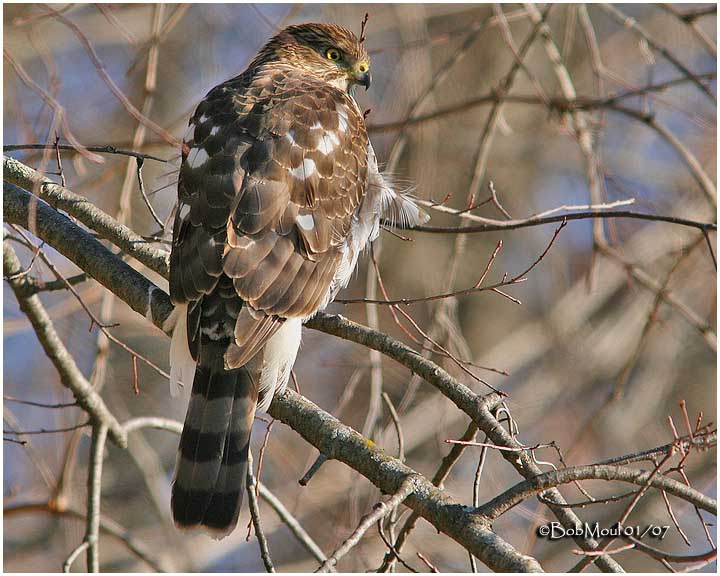
Cooper’s Hawk
Accipiter cooperii
Falconiforme Order – Accipitridae Family
BIOMETRICS:
Length: M : 38-44 cm- F : 43-49 cm
Wingspan: 64-87 cm
Weight: M : 274-421 g – F : 455-722 g
LONGEVITY: up to 12 years
DESCRIPTION:
Cooper’s Hawk is a medium-sized raptor. Adult presents a strong contrast between dark grey or grey brown back, and very dark to blackish crown. Underparts have reddish and white streaks. Tail is barred by dark bands, with a terminal white band at tip. Wings are rather short and rounded.
Hooked bill has yellow cere and dark grey tip. Eyes are reddish or orange red. Legs and feet are yellow, with black claws.
Both sexes are similar, but female is larger than male.


Juvenile presents whitish or buffy underparts, finely streaked on breast. Belly is often unstreaked. Head has tawny rufous colour. It has a broad white band at tail’s tip. Undertail coverts are white with dark brown barring. Upperparts are brown, on back and wings. Eyes are yellow.


VOICE: SOUNDS BY XENO-CANTO
Cooper’s Hawk male’s call is high pitched and quick, with some lower-pitched notes. It utters a “kek-kek-kek” around the nest. When they call at dawn, they utter a more modulated version. Their voices become lower with the age.
Young birds have high-pitched calls. Female utters a more rasping call than male.
HABITAT:
Cooper’s Hawk inhabits broken woodlands or wooded edges of rivers. It breeds in deciduous, coniferous and mixed forests, typically near open areas. It can be found in suburban and urban areas.
RANGE:
Cooper’s Hawk breeds in southern Canada, southwards to southern United States and into Central Mexico. It winters in United States and Mexico.
BEHAVIOUR:
Cooper’s Hawk is often perched on telephone poles, spending most of its time waiting for passing birds.

To feed, Cooper’s Hawk hunts flying low to approach the prey, or chasing it on short distances. When it hunts in open lands, it drops on prey from high flight. It is usually hidden, and it watches for prey, and then, it swoops down and captures it. It may pursue prey on the ground, running and flying.
Cooper’s Hawk captures a bird with its feet and it squeezes it to kill. After catching a bird or a small mammal in its talons, it may sometimes fly to water, to drown its prey.
During courtship displays, Cooper’s Hawk performs stylized flights with wings held in a deep arc. Male may fly around female, displaying its undertail coverts. It also raises the wings above its back, flying in wide circles with slow and rhythmic wing beats. These flight displays begin with pair soaring high on currents. First, male dives towards female, and follows her with a slow deep chase. Both birds fly with slow deep wing beats, interspersed with glides where white undertail coverts are spread.
Cooper’s Hawk is a territorial bird, defending its territory and nest site. It is monogamous and mates for life. It is a partially migratory bird. It often travels with others hawks.
FLIGHT:
Cooper’s Hawk is able to catch preys while flying at high speeds. It is a swift flier, using rapid wing beats, and is able to fly into heavily vegetated woodlands. It has an active flight with strong wing beats.
REPRODUCTION:
Male chooses nest site, but nest is mainly built by female.
Cooper’s Hawk’s nest is located in a fork or against the trunk of a tree. It is an open bold made with sticks, with a rim of green vegetation, and lined with bark flakes, needles and down.
Female lays 3 to 6 bluish or greenish white eggs, spotted, but becoming stained in the nest. Incubation lasts about 32 to 35 days, mainly by female, fed by the male. After hatching, both parents feed the young. They fledge at 27 to 34 days. Parents provide food during about two months.
Young reach sexual maturity at 2 years.
This species produces one brood per season.

DIET:
Cooper’s Hawk feeds mainly on birds (starlings, blackbirds, jays, robins, grouses and pheasants) and small mammals (chipmunks and squirrels). They also eat some reptiles, amphibians and insects.
PROTECTION / THREATS / STATUS:
Adults, nestlings and eggs are vulnerable to predation by other raptors. Eggs and nestlings are threatened by raccoons and crows.
Cooper’s Hawk populations decline with the use of pesticides, and destruction and loss habitat.
Cooper’s Hawk is often hunted because it attacks chickens in farms.
Fr: Cooper’s Hawk
All : Rundschwanzsperber
Esp : Gavilán de Cooper
Ital: Sparviero di Cooper
Nd: Cooper-sperwer
Russe: Ястреб Купера
Sd: Coopers hök
Photos de Bob Moul
Son site:
Nature Photography
Texte de Nicole Bouglouan
Sources :
HAWKS, EAGLES AND FALCONS OF NORTH AMERICA by Paul A. Johnsgard - Smithsonian Institution Press - ISBN: 1560989467
FIELD GUIDE TO THE BIRDS OF NORTH AMERICA - National Geographic Society - ISBN: 0792274512
A GUIDE TO THE BIRDS OF MEXICO AND NORTHERN CENTRAL AMERICA by Steve N. G. Howell, Sophie Webb - Oxford University Press - ISBN: 0198540124
BIRDS OF THE GREAT BASIN – by Fred A. Ryser - Univ of Nevada Pr -ISBN: 0874170796
All About Birds (Cornell Lab of Ornithology)
Bird Web (Seattle Audubon Society)
Animal Diversity Web (University of Michigan Museum of Zoology)
The Hawk Conservancy Trust (Hilary Smith)
What Bird-The ultimate Bird Guide (Mitchell Waite)
Wikipedia (Wikipedia, The Free Encyclopedia)